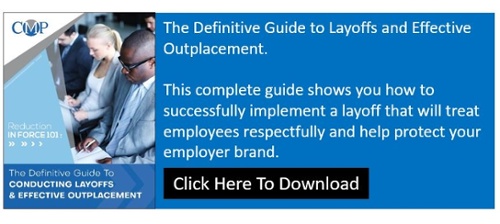Conducting a Layoff? How do you manage with sensitivity and build loyalty with the remaining employees?
Conducting a Reduction-in-Force (RIF) is one of the most challenging actions for business leaders and Human Resources. It is never taken lightly and can cause a substantial negative ripple-effect if not managed well.
We have seen RIF’s impact performance and culture for years, with the stories of the RIF being shared with multiple generations of employees.
On the poorly managed side, one Texas-based company caught in the 2008 financial crisis decided to communicate that four branches were closed, and all employees laid off, by simply locking the doors early one morning. When employees showed up to work, they were greeted by a sign stating that their jobs were terminated. There was also a sign with a number to HR for information on their benefits.
No outplacement support was provided. And, there were no clear communications to surviving employees. All the news came via the rumor mill. The stress on these employees and their families was immense. And, the negative impact on surviving employees, clients, prospects, and investors contributed to a financial drag that was felt for years. To this day, people point to that experience one-decade ago as indicative of the issues and “bad character” of management at that time.
On the well-managed side, a hardware technology company merged with a former competitor in 2012. The resulting redundancies made over 800 jobs obsolete. The people in these jobs would need to be redeployed or leave the company in a staggered rollout over ten months.
To manage the impact, an HR leader created a Program Office acting as a clearinghouse for all RIF communications, actions, open roles, and related activities. The interaction between inside and outside constituents was clear, authentic, and timely.
And, most importantly, the people impacted felt they were treated fairly and supported with the right resources in their transition. Employees to this day refer to 2012 as the year the new company “matured and built character.” As difficult as it was, the RIF built engagement among current and future employees.
Unfortunately, RIF’s happen. Whether one or one-thousand are impacted, you need to plan for the impact of the action. At a strategic level, four critical constituent groups need to be considered and managed when taking action.
Brand Enablers – how will external constituents key to the Brand (shareholders, vendors, and the community) perceive the action?
- Generally, people will understand and even appreciate the need for management to take decisive action. Key individuals require a phone call; others need heads-up communications early in the process. We have seen Brand Enablers, such as the local community, provide support, and even come to the defense of the company, when they are treated as a key constituent.
Current Clients – how the action will impact client relationships? What are appropriate proactive and reactive communications?
- Generally, current clients will want to understand the impact on existing services and operations. Even if there is no direct impact, it is essential to over-communicate, so they don’t receive inaccurate information from other sources and needlessly worry. Make sure the clients know they are being considered and taken care of.
Surviving Employees – what concerns and questions will current employees need to have answered to re-engage?
- Seeing their co-worker(s), even friend(s) severed from the company, is an emotional experience, even if it is anticipated. It starts with personal impact - remaining employees will want to know if more reductions are going to happen. And, they will want to know that their former co-workers/friends are being supported, and treated fairly, in their transition.
Impacted Employees – what is the right thing to do for those impacted?
- Lastly, but most importantly, those impacted by a RIF need support at tactical and emotional levels. People in the company can’t provide this – impacted employees need effective outplacement support that helps them move forward productively.
Effective outplacement support is integral to managing each of the four constituent groups above – especially Surviving and Impacted Employees,
The support they receive will “tell the story” of how the company views employees to all constituents for years to come. Effective outplacement does not need to be costly, but does need to have the following three elements to realize the full impact and ROI:
- Career transition coach is more important than ever. While technology is an excellent aid in the job search process, every study on outplacement over the last ten years suggests that the career coach is still the most important component of the process. The nuanced feedback of a seasoned career coach can’t be replaced with a video.
- Social media networking is a science that can be learned. If an impacted employee does not know how to conduct a job search using channels like LinkedIn and Facebook, they are at a tremendous disadvantage. There are just too many opportunities that come from networking online to be glazed over. Make sure to discuss technology and e-learning in-depth with your outplacement provider.
- Job Matches – most laid-off workers care mostly about getting a job. Electronic job matches help facilitate the job search.
Managing a RIF effectively is both the humane thing to do and the business-smart thing to do. The markers listed above can help you take steps that will impact people and businesses positively for years to come.




